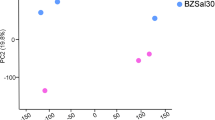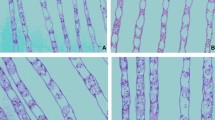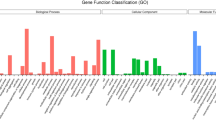Abstract
The Iwagaki oyster Crassostrea nippona is an important aquaculture species with significant potential for large-scale oyster farming. It is susceptible to the fluctuated salinity in the coastal area. In this study, we compared the transcriptome of Crassostrea nippona larvae under variant conditions with low-salinity stress (28, 20, 15, 10, and 5 practical salinity units (psu)) for 24 h. KEGG enrichment analysis of differentially expressed genes (DEGs) from pairwise comparisons identified several free amino acid metabolism pathway (taurine and hypotaurine, arginine and proline, glycine, and beta-alanine) contributing to the salinity change adaptation and activated “lysosome” and “apoptosis” pathway in response to the low-salinity stress (10 and 5 psu). Trend analysis revealed sustained upregulation of transmembrane transport–related genes (such as SLC family) and downregulation of ribosomal protein synthesis genes faced with decreasing salinities. In addition, 9 biomarkers in response to low-salinity stress were identified through weighted gene co-expression network analysis (WGCNA) and validated by qRT-PCR. Our transcriptome analysis provides a comprehensive view of the molecular mechanisms and regulatory networks underlying the adaptive responses of oyster larvae to hypo-salinity conditions. These findings contribute to our understanding of the complex biological processes involved in oyster resilience and adaptation to changing environmental conditions.










Similar content being viewed by others
Availability of Data and Material
All data generated or analyzed during this study are included in this article and supplementary information.
References
Berger VJ, Kharazova AD (1997) Mechanisms of salinity adaptations in marine molluscs. In: Interactions and adaptation strategies of marine organisms. Springer 121:115–126
Botta R, Asche F, Borsum JS, Camp EV (2020) A review of global oyster aquaculture production and consumption. Mar Policy 117:103952
Bourque CW (2008) Central mechanisms of osmosensation and systemic osmoregulation. Nat Rev Neurosci 9:519–531
Bradley TJ (2009) Animal osmoregulation. Oxford University Press
Chen MQ, Yu G, Ma ZH, Li YN, Xing KW, Wang L (2016) Effect of salinity changes on haemocyte of pearl oyster Pinctada Martensii. J Coast Life Med 4:757–759
Droga-Mazovec G, Bojič L, Petelin A, Ivanova S, Romih R, Repnik U, Salvesen GS, Stoka V, Turk V, Turk B (2008) Cysteine cathepsins trigger caspase-dependent cell death through cleavage of bid and antiapoptotic Bcl-2 homologues. J Biol Chem 283:19140–19150
Ertl NG, O’Connor WA, Elizur A (2019) Molecular effects of a variable environment on Sydney rock oysters, Saccostrea glomerata: thermal and low salinity stress, and their synergistic effect. Mar Genomics 43:19–32
Evans TG, Kültz D (2020) The cellular stress response in fish exposed to salinity fluctuations. J Exp Zool 333:421–435
George MN, Cattau O, Middleton MA, Lawson D, Vadopalas B, Gavery M, Roberts SB (2023) Triploid Pacific oysters exhibit stress response dysregulation and elevated mortality following heatwaves. Glob Chang Biol. https://doi.org/10.1111/gcb.16880
Gong J, Li Q, Yu H, Liu S, Kong L (2022) Effects of low salinity on hemolymph osmolality and transcriptome of the Iwagaki oyster, Crassostrea nippona. Fish Shellfish Immunol 126:211–216
Griffiths JS, Johnson KM, Sirovy KA, Yeats MS, Pan FT, La Peyre JF, Kelly MW (2021) Transgenerational plasticity and the capacity to adapt to low salinity in the Eastern oyster, Crassostrea virginica. Proc R Soc B Biol Sci 288:20203118
Gunter G (1955) Mortality of oysters and abundance of certain associates as related to salinity. Ecol 36:601–605
Hosoi M, Kubota S, Toyohara M, Toyohara H, Hayashi I (2003) Effect of salinity change on free amino acid content in Pacific oyster. Fisheries Sci 69:395–400
Hosoi M, Shinzato C, Takagi M, Hosoi-Tanabe S, Sawada H, Terasawa E, Toyohara H (2007) Taurine transporter from the giant Pacific oyster Crassostrea gigas: function and expression in response to hyper-and hypo-osmotic stress. Fisheries Sci 73:385–394
Hu X, Hu X, Hu B, Wen C, Xie Y, Wu D, Tao Z, Li A, Gao Q (2014) Molecular cloning and characterization of cathepsin L from freshwater mussel, Cristaria plicata. Fish Shellfish Immunol 40:446–454
Huang X, Jiang X, Sun M, Dupont S, Huang W, Hu M, Li Q, Wang Y (2018) Effects of copper on hemocyte parameters in the estuarine oyster Crassostrea rivularis under low pH conditions. Aquat Toxicol 203:61–68
Ito T, Fujio Y, Hirata M, Takatani T, Matsuda T, Muraoka S, Takahashi K, Azuma J (2004) Expression of taurine transporter is regulated through the TonE (tonicity-responsive element)/TonEBP (TonE-binding protein) pathway and contributes to cytoprotection in HepG2 cells. Biochem J 382:177–182
Ko GWK, Dineshram R, Campanati C, Chan VB, Havenhand J, Thiyagarajan V (2014) Interactive effects of ocean acidification, elevated temperature, and reduced salinity on early-life stages of the Pacific oyster. Environ Sci Technol 48:10079–10088
La Peyre MK, Geaghan J, Decossas G, Peyre JFL (2016) Analysis of environmental factors influencing salinity patterns, oyster growth, and mortality in lower Breton Sound estuary, Louisiana, using 20 years of data. J Coast Res 32:519–530
Leaf A (1959) Maintenance of concentration gradients and regulation of cell volume. Ann N Y Acad Sci 72:396–404
Lee SH, Lee MC, Puthumana J, Park JC, Kang S, Hwang DS, Shin KH, Pak HG, Souissi S, Om AS, Lee JS, Han J (2017) Effects of salinity on growth, fatty acid synthesis, and expression of stress response genes in the cyclopoid copepod Paracyclopina nana. Aquaculture 470:182–189
Li A, Dai H, Guo X, Zhang Z, Zhang K, Wang G, Wang X, Wang W, Chen H, Zheng LX, H, Li L, Zhang G (2021) Genome of the estuarine oyster provides insights into climate impact and adaptive plasticity. Commun Biol 4:1287
Li C, Wang H, Guo X (2022) Regulation of the cell cycle, apoptosis, and proline accumulation plays an important role in the stress response of the eastern oyster Crassostrea Virginica. Front Mar Sci 9:921877
Lin CH, Yeh PL, Lee TH (2021) Time-course changes in the regulation of ions and amino acids in the hard clam Meretrix lusoria upon lower salinity challenge. J Exp Zool A Ecol Integr Physiol 335:602–613
Liu X, Wang WX (2016) Physiological and cellular responses of oysters (Crassostrea hongkongensis) in a multimetal-contaminated estuary. Environ Toxicol Chem 35:2577–2586
Lu J, Shi Y, Yao T, Bai C, Jiang J, Ye L (2021) Gender differences in hemocyte immune parameters of Hong Kong oyster Crassostrea hongkongensis during immune stress. Front Immunol 12:659469
Livak KJ, Schmittgen TD (2001) Analysis of relative gene expression data using real-time quantitative PCR and the 2−ΔΔCT method. Methods 25:402–408
McNamara JC, Faria SC (2012) Evolution of osmoregulatory patterns and gill ion transport mechanisms in the decapod Crustacea: a review. J Comp Physiol b: Biochem Syst Environ Physiol 182:997–1014
Meng J, Zhu Q, Zhang L, Li C, Li L, She Z, Huang B, Zhang G (2013) Genome and transcriptome analyses provide insight into the euryhaline adaptation mechanism of Crassostrea gigas. PLoS ONE 8:e58563
Niu D, Jin K, Wang L, Sun F, Li J (2013) Identification of cathepsin B in the razor clam Sinonovacula constricta and its role in innate immune responses. Dev Comp Immunol 41:94–99
Oliveira FAA, Buri MV, Rodriguez BL, Costa-da-Silva AL, Araújo HR, Capurro ML, Lu S, Tanaka AS (2020) The first characterization of a cystatin and a cathepsin L-like peptidase from Aedes aegypti and their possible role in DENV infection by the modulation of apoptosis. Int J Biol Macromol 146:141–149
Padmini E, Tharani J (2014) Heat-shock protein 70 modulates apoptosis signal-regulating kinase 1 in stressed hepatocytes of Mugil cephalus. Fish Physiol Biochem 40:1573–1585
Pasantes-Morales H, Lezama RA, Ramos-Mandujano G, Tuz KL (2006) Mechanisms of Cell volume regulation in hypo-osmolality. Am J Med 119:S4–S11
Perry RP (2007) Balanced production of ribosomal proteins. Gene 401:1–3
Pierce SK (1982) Invertebrate cell volume control mechanisms: a coordinated use of intracellular amino acids and inorganic ions as osmotic solute. Biol Bull 163:405–419
Pourmozaffar S, Tamadoni Jahromi S, Rameshi H, Sadeghi A, Bagheri T, Behzadi S, Gozari M, Zahedi MR, Abrari Lazarjani S (2020) The role of salinity in physiological responses of bivalves. Rev Aquac 12:1548–1566
Rahman MS, Rahman MS (2021) Effects of elevated temperature on prooxidant-antioxidant homeostasis and redox status in the American oyster: signaling pathways of cellular apoptosis during heat stress. Environ Res 196:110428
Rashid K, Ahmad A, Liang L, Liu M, Cui Y, Liu T (2021) Solute carriers as potential oncodrivers or suppressors: their key functions in malignant tumor formation. Drug Discov Today 26:1689–1701
Rybovich M, Peyre MKL, Hall SG, Peyre JFL (2016) Increased temperatures combined with lowered salinities differentially impact oyster size class growth and mortality. J Shellfish Res 35:101–113
Sadri S, Khoei AJ (2023) Ambient salinity affects silver nanoparticles (AgNPs) induced toxicity in the marine bivalve, the rock oyster. Saccostrea Cucullata Aquac Rep 30:101596
Scharping RJ, Plough LV, Meritt DW, North EW (2019) Low-salinity tolerance of early-stage oyster larvae from a mesohaline estuary. Mar Ecol Prog Ser 613:97–106
Song X, Lü W, Ibrahim S, Deng Y, Li Q, Yue C (2023) Identification of free amino acids (FAA) that are important as major intracellular osmolytes in the estuarine Hong Kong oyster. Crassostrea Hongkongensis Aquac Rep 28:101464
Strange K (2004) Cellular volume homeostasis. Adv Physiol Educ 28:155–159
Szabados L, Savouré A (2010) Proline: a multifunctional amino acid. Trends Plant Sci 15:89–97
Toyohara H, Yoshida M, Hosoi M, Hayashi I (2005) Expression of taurine transporter in response to hypo-osmotic stress in the mantle of Mediterranean blue mussel. Fish Sci 71:356–360
Willmer P (2006) Osmoregulation in invertebrates. eLS. https://doi.org/10.1038/npg.els.0003646
Witkop EM, Proestou DA, Gomez-Chiarri M (2022) The expanded inhibitor of apoptosis gene family in oysters possesses novel domain architectures and may play diverse roles in apoptosis following immune challenge. BMC Genomics 23:201
Wu B, Chen X, Yu M, Ren J, Hu J, Shao C, Zhou L, Sun X, Yu T, Zheng Y, Wang Y, Wang Z, Zhang H, Fan G, Liu Z (2022) Chromosome-level genome and population genomic analysis provide insights into the evolution and environmental adaptation of Jinjiang oyster Crassostrea ariakensis. Mol Ecol Resour 22:1529–1544
Yancey PH (2005) Organic osmolytes as compatible, metabolic and counteracting cytoprotectants in high osmolarity and other stresses. J Exp Biol 208:2819–2830
Yang Y, Han L, Yuan Y, Li J, Hei N, Liang H (2014) Gene co-expression network analysis reveals common system-level properties of prognostic genes across cancer types. Nat Commun 5:3231
Zhang X, Yuan J, Zhang X, Yu Y, Li F (2022) Comparative transcriptomic analysis unveils a network of energy reallocation in Litopenaeus vannamei responsive to heat-stress. Ecotoxicol Environ Saf 238:113600
Zhang Z, Li A, She Z, Wang X, Jia Z, Wang W, Zhang G, Li L (2023) Adaptive divergence and underlying mechanisms in response to salinity gradients between two Crassostrea oysters revealed by phenotypic and transcriptomic analyses. Evol Appl 16:234–249
Zhao X, Li Q, Meng Q, Yue C, Xu C (2017) Identification and expression of cysteine sulfinate decarboxylase, possible regulation of taurine biosynthesis in Crassostrea gigas in response to low salinity. Sci Rep 7:1–10
Zhao X, Yu H, Kong L, Li Q (2012) Transcriptomic responses to salinity stress in the Pacific oyster Crassostrea gigas. PLoS ONE 7:e46244
Funding
This research was supported by grants from Earmarked Fund for Agriculture Seed Improvement Project of Shandong Province (2021ZLGX03, 2022LZGCQY010 and 2021LZGC027) and China Agriculture Research System Project (CARS-49).
Author information
Authors and Affiliations
Contributions
Conceptualization, methodology, write original draft: Jianwen Gong. Review and editing: Qi Li.
Corresponding author
Ethics declarations
Ethics Approval and Consent to Participate
C. nippona is neither an endangered nor protected species. All experiments in this study were conducted according to the national and institutional guidelines.
Competing Interests
The authors declare no competing interests.
Additional information
Publisher's Note
Springer Nature remains neutral with regard to jurisdictional claims in published maps and institutional affiliations.
Supplementary Information
Below is the link to the electronic supplementary material.
Rights and permissions
Springer Nature or its licensor (e.g. a society or other partner) holds exclusive rights to this article under a publishing agreement with the author(s) or other rightsholder(s); author self-archiving of the accepted manuscript version of this article is solely governed by the terms of such publishing agreement and applicable law.
About this article
Cite this article
Gong, J., Li, Q. Comparative Transcriptome and WGCNA Analysis Reveal Molecular Responses to Salinity Change in Larvae of the Iwagaki Oyster Crassostrea Nippona. Mar Biotechnol 25, 1031–1042 (2023). https://doi.org/10.1007/s10126-023-10257-w
Received:
Accepted:
Published:
Issue Date:
DOI: https://doi.org/10.1007/s10126-023-10257-w




